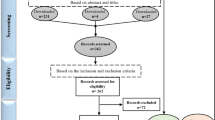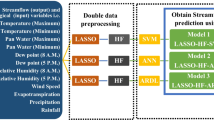Abstract
While active learning method (ALM) uses error as the learning parameter, selection of the validation data is still challenging. In this paper, to prevent form encountering with sample size problem, we applied an error-independent version of ALM that we call the active fuzzy modeling (AFM) with a distance threshold to model parameters of hydrocarbon reservoirs. In this paper, we demonstrate that measuring the generalization error is a vital factor in the process of ALM. Regression (R) and mean squared error (MSE) for estimating RHOB by AFM were 0.96 and 0.0032, respectively. On the other hand, R of 0.91, 0.89 and 0.92 and MSE of 0.0051, 0.0067 and 0.0047 for ANN, TS-FIS and NF, respectively, illustrate that AFM performs much better in comparison with conventional modeling approaches and produces more reliable results. Comparing the results of the presented method with ANN, TS-FIS and NF in aspect of rapidity, robustness, storage, complexity and acceptability in estimating RHOB reports the accuracy and high-performance behavior of AFM. This method is illustrated by an example of an oil field at NW Persian Gulf.










Similar content being viewed by others
References
Söderström T, Stoica P (2001) System identification. Prentice Hall, Englewood Cliffs
El-Sebakhy EA, Asparouhov O, Abdulraheem A-A, Al-Majed A-A, Wu D, Latinski K et al (2012) Functional networks as a new data mining predictive paradigm to predict permeability in a carbonate reservoir. Expert Syst Appl 39:10359–10375
Mohaghegh S-D (2011) Reservoir simulation and modeling based on artificial intelligence and data mining (AI&DM). J Nat Gas Sci Eng 3:697–705
Cranganu C, Breaban M (2013) Using support vector regression to estimate sonic log distributions: a case study from the Anadarko Basin, Oklahoma. J Pet Sci Eng 103:1–13
Cranganu C, Bautu E (2010) Using gene expression programming to estimate sonic log distributions based on the natural gamma ray and deep resistivity logs: a case study from the Anadarko Basin, Oklahoma. J Pet Sci Eng 70:243–255
Al-Marhoun MA, Nizamuddin S, Raheem AAA, Ali SS, Muhammadain AA (2012) Prediction of crude oil viscosity curve using artificial intelligence techniques. J Pet Sci Eng 86–87:111–117
Morooka CK, Guilherme IR, Mendes JRP (2001) Development of intelligent systems for well drilling and petroleum production. J Pet Sci Eng 32:191–199
Zoveidavianpoor M, Shadizadeh SR (2013) Adaptive neuro fuzzy inference system for compressional wave velocity prediction in a carbonate reservoir. J Appl Geophys 89(89):96–107
Shouraki SB, Honda N (1999) Recursive fuzzy modeling based on fuzzy interpolation. J Adv Comput Intell 3(2):114–125
Shouraki SB, Honda N (1997) A new method for establishment and saving fuzzy membership functions. In: 13th fuzzy symposium, Toyama, pp 91–94
Shouraki SB, Honda N (1997) Outlines of a living structure based on biological neurons for simulating the Active Learning Method. In: 7th intelligent systems symposium. Sapporo, pp 183–188
Bahrpeyma F, Golchin B, Cranganu C (2013) Fast fuzzy modeling method to estimate missing logs in hydrocarbon reservoirs. J Pet Sci Eng 112:310–321
Bahrpeyma F, Cranganu C, Zamani B (2015) Active learning method for estimating missing logs in hydrocarbon reservoirs. In: Cranganu C (ed) Artificial intelligent approaches in petroleum geosciences, Springer
Bahrpeyma F, Cranganu C Golchin B (2015) Improving the accuracy of active learning method via noise injection for estimating hydraulic flow units: an example from a heterogeneous carbonate reservoir. In: Cranganu C (ed) Artificial intelligent approaches in petroleum geosciences, Springer
Cranganu C, Bahrpeyma F (2015) Use of active learning method to determine the presence and estimate the magnitude of abnormally pressured fluid zones: a case study from the Anadarko Basin, Oklahoma. In: Cranganu C (ed) Artificial intelligent approaches in applied geosciences, Springer
Murakami M, Honda N (2005) A comparative study of the IDS method and feedforward neural networks, presented at the international joint conference on neural networks, Montreal
Murakami M, Honda N (2007) A fast structural optimization technique for IDS modeling, presented at the fuzzy information processing society in 2007, NAFIPS ‘07. Annual Meeting of the North American
Murakami M, Honda N (2004) Hardware for a new fuzzy-based modeling system and its redundancy. In: 23rd international conference of the North American fuzzy information processing society (NAFIPS’04), pp 599–604
Sagha H, Shouraki SB, Khasteh H, Dehghani M (2008) Real-time IDS using reinforcement learning, presented at the second international symposium on intelligent information technology application
Sagha H, Shouraki SB, Beigy H, Khasteh H, Enayati E (2008) Genetic ink drop spread, presented at the second international symposium on intelligent information technology application
Murakami M, Honda N (2005) A study on the real-time modeling capabilities of the IDS method. In: Fuzzy systems, the 14th IEEE international conference on 2005. FUZZ’05, pp 803–808
Murakami M, Honda N (2005) A study on the modeling ability of the IDS method: a soft computing technique using pattern-based information processing. Int J Approx Reason 45:470–487
Bahrpeyma F, Zakerolhoseini A, Haghighi H (2015) Using IDS fitted Q to develop a real-time adaptive controller for dynamic resource provisioning in Cloud’s virtualized environment. Appl Soft Comput 26:285–298
Hamid RT, Shouraki SB, Fell F, Abrishamchi A, Tajrishy M, Fischer J (2006) Investigating the ability of active learning method for chlorophyll and pigment retrieval in case-I waters using seawifs wavelengths. Int J Remote Sens 28(20):4677–4683
Takagi T, Sugeno M (1985) Identification of systems and its application to modeling and control. Inst Elect Electron Eng Trans Syst Man Cybern 15:116–132
Abbass HA, Sarker RA, Newton CS (2002) Data mining: a heuristic approach. Idea Group Publishing, Hershey
Rezaee MR, Kadkhodaie-Ilkhchi A, Alizadeh PM (2008) Intelligent approaches for the synthesis of petrophysical logs. J Geophys Eng 5:12–26
Vaferi B, Eslamloueyan R, Ayatollahi S (2011) Automatic recognition of oil reservoir models from well testing data by using multi-layer perceptron networks. J Pet Sci Eng 77:254–262
Alizadeha B, Najjaria S, Kadkhodaie-Ilkhchi A (2012) Artificial neural network modeling and cluster analysis for organic facies and burial history estimation using well log data: a case study of the South Pars Gas Field, Persian Gulf, Iran. Comput Geosci 45:261–269
Ashenaa R, Moghadasi J (2011) Bottom hole pressure estimation using evolved neural networks by real coded ant colony optimization and genetic algorithm. J Pet Sci Eng 77:375–385
Mhaskar HN, Micchelli CA (1992) Approximation by superposition of sigmoidal and radial basis functions. Adv Appl Math 13:350–373
Bagheripour P, Asoodeh M (2013) Fuzzy ruling between core porosity and petrophysical logs: subtractive clustering versus genetic algorithm–pattern search. J Appl Geophys 99:35–41
MATLAB user’s guide (2010) Neural network, fuzzy logic and optimization toolboxes user’s guides (MATLAB CD-ROM). Mathworks, Inc., Natick
Kadkhodaie-Ilkhchi A, Rezaee MR, Moallemi SA (2006) A fuzzy logic approach for the estimation of permeability and rock types from conventional well log data: an example from the Kangan reservoir in Iran Offshore Gas Field. J Geophys Eng 3:356–369
Rajabi M, Bohloli B, Gholampour Ahangar E (2010) Intelligent approaches for prediction of compressional, shear and Stoneley wave velocities from conventional well log data: a case study from the Sarvak carbonate reservoir in the Abadan Plain (Southwestern Iran). Comput Geosci 36(5):647–664
Roshani GH, Feghhi SAH, Adineh-Vand A, Khorsandi M (2013) Application of adaptive neuro-fuzzy inference system in prediction of fluid density for a gamma ray densitometer in petroleum products monitoring. Measurement 46(9):3276–3281
Khazraee SM, Jahanmiri AH (2010) Composition estimation of reactive batch distillation by using adaptive neuro-fuzzy inference system. Chin J Chem Eng 18:703–710
Rumelhart DE, Hinton GE, Williams RJ (1988) Learning representations by back-propagating errors. Cognit Model 5:3
Author information
Authors and Affiliations
Corresponding author
Rights and permissions
About this article
Cite this article
Fasanghari, M., Bahrpeyma, F. & Jolai, F. Active fuzzy modeling for estimating problems in hydrocarbon reservoirs. Neural Comput & Applic 27, 1981–1992 (2016). https://doi.org/10.1007/s00521-015-1992-y
Received:
Accepted:
Published:
Issue Date:
DOI: https://doi.org/10.1007/s00521-015-1992-y




